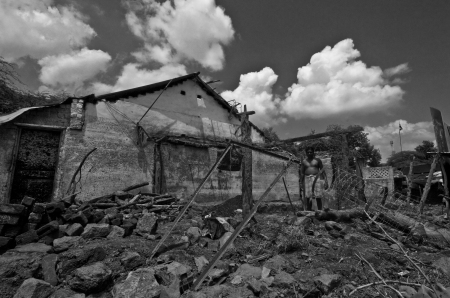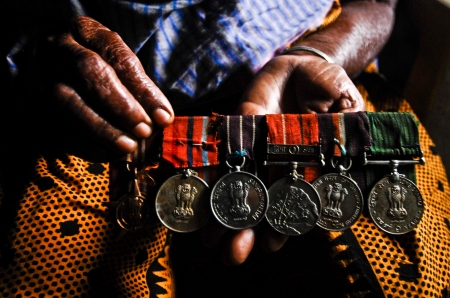 The polling booth at Mayapur, Palamau District of Jharkhand on the 10th of April, 2014.
The polling booth at Mayapur, Palamau District of Jharkhand on the 10th of April, 2014.
Constants seldom make election campaigns, and election results seldom challenge them. C for Corruption but then it is C for Caste, Counterinsurgency and Contrator-raj, that are constants in Palamau district of Jharkhand, and then there is C for cynicism: the language, religion, and soul of every voter, whether he believes in Modi or not, in Laloo or not, who knows things will seldom change in the village, no matter who will win the election, where this time an incumbent ex-Maoist is finding his challenge in an ex-cop and an ex-minister.
In Palamau district at Daltonganj, on the 8th of April, a Ram Navmi jhooloos would play a nationalist song calling for Hindu-Muslim-Christian unity, and the chorus would blare in a guttural voice, ‘Hindustan Zindabad’ repeatedly, with the next chorus including ‘Pakistan Murdabad’. The city was planted with red flags, Hanuman jhandas, and in the evening the administration shut off the power across the block to ensure no accidents could take place, such as the one on the 13th of April, 2000, when a flag procession broke off a 11,000 volt cable that would kill over 30 people at Kasab Mohalla at Daltonganj. Ram Navmi flags were even placed on the Ambedkar statue at Barwadih block, a statue built by supporters of the Rashtriya Janta Dal who didn’t find the sense of misplacement in the act. Over two decades ago, in the village of Balatola with a significant population of Brahmins and Rajputs, the caste system was described through cricket: ‘All the upper caste boys would just bat, and all the lower caste boys would only field and bowl.’
Palamau and Garhwa (Constituency Number 13) is meant for the Reserved Category. The sitting Minister of Parliament Kameshwar Baitha was once a part of the Naxalite insurgency, who won the 2009 seat on a Jharkhand Mukti Morcha ticket while serving a jail term. In the previous election he lost to Ghuran Ram of the RJD by a mere 22,327 votes. It is common knowledge that he joined the CPI Maoist (Party Unity) after the Arwal massacre of Jehanabad on the 19th of April, 1986, where 21 members of the leftist Mazdoor Kisan Sangarsh Samiti were killed by the police. But even by asking 267 questions in parliament, his popularity in the region had waned dramatically in the past five years. He was eventually ditched by the JMM and is currently standing with a Trinamool Congress ticket, after failing in his attempts to win the favours of the BJP, who would eventually field ex-Director General of Police, Vishnu Dayal Ram, a 1973 batch IPS officer, who was the Superintendent of Police during the infamous Bhagalpur blinding incident of 1979-1980, where 31 undertrials had acid poured into their eye sockets by the police.
Yet touring the districts of Palamau and Garhwa it is almost unanimously agreed that the battle is between the RJD’s Manoj Bhuyan and BJP’s V.D. Ram for whom the recent Ramnami celebrations on the 8th of April, and the Modi factor is helping to push votes towards him, especially amongst the landed, dominant and forward castes.
Manoj Bhuyan, has a mixed consolidation of Yadav, Bhuyan and Muslim votes.
When Palamau and Garhwa went to the polls on the 10th of April, 2014 in the first phase of elections in Jharkhand, 1,417,375 voters were meant to practice their franchise but a mere 59.3% showed up for polling. The M factor, wasn’t as much as the Maoist boycott as the Mahua factor, that during the last few days of the fruits falling onto the rich earth, adivasi villagers whose sole source of income for months would be Mahua, would only want to vote after they collected their quota of Mahua for the day, but polling ended at 4 in the evening, leaving many out of the process.
At empty polling booths, disgruntled security personnel were annoyed at how villagers would rather pick up mahua than vote, obviously missing out how the world’s largest democracy could be a farce.
‘Ka maloom kisko vote diya (Who knows who I gave my vote to?)’ Said an old man who came alone and walked away with sheer disinterest in the polling booth at Uldanda Panchayat at Palamau district. A young man, ‘a good samaritan’, held his hand to make him vote, and he wasn’t the only one to whom the act of voting is a mere habit, a connection to this invisible ‘sarkar’, and nothing else. Another man with his grandson under a Mahua tree in Chainpur block, would rather ask journalists who he should vote for, and who we think will save the nation. Suryabed Devi from the village of Dorami would find her name would not be on the list, and would visit the polling booth thrice in the day to try and vote for ‘sarkar ke niyaam’ (government schemes). When she was asked by an observer from Delhi if she knew the ‘Jhadoo wala party’, she responded that she knew what a ‘Jhadoo (broom)’ was.
Over 25 kilometres away, a BJP polling agent, sat around a coterie of 20-30 villagers near the empty Mayapur polling station in Chainpur block of Palamau, distributing election papers with their serial numbers, to make it easier for voters to find their names on the roster. On the first question about the ‘samasya (problems)’ of the village, ten people would all start to speak as once, talking about pani (water), bijli (electricity), ration and job card while the polling agent kept quiet. They were a divided bunch with no one clearly espousing support for any party, with some voices invoking the ‘Lantern’ and others ‘Phool’ (lotus), while there was unanimous mistrust towards their incumbent minister Kameshwar Baitha.
‘Aap abhi bharosa kaise rakhege? (How can you trust them now?)’ I had asked the group.
‘Toh kay karenge! (What do we do?),’ they said in a chorus. One man exhorts, ‘Vishwas peh jaahte hai mandir ko, mil jata hai tho mil jata hai! (We go to the temple in faith, if we get what we wish for, then we get it.)’
At some point during the cacophony of discussion, and hyperbolic cycnicism, the polling agent, finally called for order to speak, ‘Hamare Narendra Modi ke laksh mein saare vote jara he.(All our votes are going towards Narendra Modi).’He said, the man approaching fifty who spoke with absolute conviction and sombreness, ‘Woh pradhan mantri baneye, aur desh ka udhar karenge. (He’ll become the prime minister and make the country progress)’
‘Gaon ke samasye mein badal aayega? (Will the village’s problems get fixed?)’ I asked.
Silence.
Then a cacophony again. Mostly saying no.
‘Koi bhi jeeta aase koi bhi umeed nahi hai. (Whoever wins, we don’t have any hopes like that).’ Said a younger man, ‘Aapna khandaan hi banate ha (They only help their own families). Garibo kya kar raha hai, kha raha hai, kapda penh raha hai, chhao mein bheta hai, usse koi matlab nahi hai (What the poor are doing, what they’re eating, what clothes they’re wearing, whether they have shade to sit in, none of that matters). Woh jieetne ke baadh woh bus aapna sochtha hai (Once they win, they just think of themselves).’
Another man spoke at the very instance, ‘Koi jeetega, garib ka dekhneka koi nahi hai , agar 100 ghar hai, yaha 50 ghar mein kuch nahi hai, koi card nahi, koi job card nahi. Aur kuch nahi hoga unka! (Whoever wins, nobody is going to look after the poor, if there are 100 houses here, there is nothing in 50 houses, no card, no job card. Nothing will happen for them). ’
The polling agent kept quiet. He didn’t wish to speak anymore.
Speaking to villagers after villagers, there was an obvious sense of abandonment, of the village, of the self, of the community amongst a majority of people who went to the polls. Yet there were some places where the issues were not issues, and the struggles were entirely their own.
Counterinsurgency

Memorial for the dead at Barhania village in Latehar District of Jharkhand.
Around 55 kilometers from Palamau, it was in Barhania village in Murvai Panchayat in Latehar district that on the 15th of April, 2009, a day before polling for the Lok Sabha elections that an IED blast on a polling party, would claim the lives of two CRPF personel and one civilian driver Vijay Kumar Prasad. And in an act (that is always disputed by the police), that can only be described as a revenge killing, the angry CRPF survivors marched to the nearest village and arbitrarily killed five people – Supay Bodra (18), Sanjay Bodra (20), Masi Soma Bodra (14), Pitai Munda (32) and Supay Bodra (55), and claimed they killed five Naxalites. The incident on the peak of the elections, led to a frenzy of accusations, anger, and promises, and the fact that the village, has contributed 17 people to the Army or the Border Security Forces or the Jharkhand state police or the CISF, and is then branded a ‘Naxalite village’, did not escape public scrutiny.
Army Jawaan Joel Budra, whose own family members were killed on that day, would eventually leave the Bihar Regiment a few years after the killings, and still remembers the day his own colleagues who saw the news bulletins, started to insinuate that he comes from a village of ‘ugravadis (extremists)’ .
‘Abhi bhi yaad aata hai unka (I still remember them).’ He says about his family members, he himself is almost half his size today, and spends his time working in the fields when there is work.
‘Police se gussa to aata hai, hum bhi police to the, aur mera bhai Martin bhi policewalla hai, lekin usko bhi gussa hai (We do get angry at the police, I was also in the police and my brother Martin is also a policeman, and he gets angry too).’
The site of the attack today is dotted with two memorials, one for the driver killed in the attack set up by the transport association, a statue of stone whose ankles are beaten down and another by the villagers of Barhania with the names of the villagers and details of the incident that clearly indicts the CRPF. Over the past few years the CRPF patrols have constantly erased ‘CRPF’ from the plaque, and the adivasis keep writing it again.
Jawaan Mangram Munda, who is part of the CISF categorically states, that the villagers were innocent and that the massacre wouldn’t have taken place if he was there in the village the day of the attack. He was himself at Chatra at election duty, and is visibly angry with the CRPF who acted rashly but has an entirely different relationship to the state than others in his village, and is openly espousing his support for the AAP in Latehar on the issue of corruption, even though there is no visible sight of the party across the region.
On the day of the killing, every political party from the Jharkhand Mukti Morcha, to the Jharkhand Vikas Morcha, to the Bharatiya Janata Party, to the Rashtriya Janata Dal, the CPI(ML)-Liberation, and Communist Party of India, to human rights organizations and the national media would visit the village, whose lack of irrigation facilities had affected migrancy and livelihood as much as the massacre. In 2009, the families of the victims would never go to the polls, and five years later, their voices stand divided, with some still refusing to vote, and some believing they would vote for the Congress’s Dhiraj Prasad Sahu, who had given each of the families Rs.20,000 as compensation, and has promised to re-open collieries, re-open the Chirimiri railway line and to complete the Mandal Dam which will drown countless trees and submerge villages, to the chagrin of other adivasi groups. Their incumbent candidate, Inder Singh Namdhari, who ran as an independent, only visited the village once, and had called for a review into the incident, when the villagers was already cleared by then.
‘I didn’t vote last time,’ Said Gauri Budhra from Barhania, ‘And this time I have to spend my time picking Mahua, and I will probably be too tired to walk 2 kilometres in the sun to vote.’
‘What if there was a complete gaurantee that the water problems in the village would be solved if you voted?’ I asked.
She laughed.
‘I would still not go. Who trusts these people!’
Soni Mundoo, about 50 years of age, sister of Pitai Munda who was killed in the attack felt the same. ‘Why vote after they killed our people?’ While her family voted for the panchayat elections, further questioning led her to say, ‘And I am alone, why should I go? There is so much work.’
Contractor-Raj

Migrant workers returning from Bangalore an evening before polling day.
During the Mahua season, the Munda, Oraon and Chero adivasis of Palamau-Chatra-Garhwa and Latehar collect as much Mahua as they can for their home, and sell what they can in the market. The markets are run by ‘Mahajans’ with whom there is no bargaining over price. It starts at Rs.30 per kilo, and over the next few weeks as more and more trees grow mahua fruits, the price goes down to Rs.25, to Rs.20. Then, in a few months, the Mahajans will sell the Mahua back to the adivasis at Rs.40 or Rs.50 a kilogram when there is none left in the forest. A system in place for there is no organized effort by the government to build godowns, or to protect adivasi interests.
In every village moving towards the interior, incomplete roads, incomplete government buildings dot the landscape. In every conversation, there was always someone or the other from Daltonganj or Ranchi, from anywhere but here, who built half of a road, or half of a building, or nothing at all. It was in Latehar, where on the 2nd of March, 2011, where the CPI Maoists, in collusion with a contractor had murdered Niyamat Ansari, an activist fighting for proper implementation of MNREGA, who built a pond through a government scheme in the panchayat, who repeatedly invoked the RTI act and the Forest Rights act. The local Maoist commander Sudarshan would accuse him of stealing land, stealing from the poor, ‘child sacrifice’ but would eventually be forced to ‘apologize’ by his leadership.
Another incident where the role of the contractors is pushed to an afterthought took place in Garhwa, when an IED blast on the 21st of January, 2012 had claimed the lives of 13 police personnel, who were accompanying the local Block Development Officer Vasudev Prasad to a protest site at Bargad, where villagers were protesting against how their health center, meant for the village Ghotoni was being built at Bargad by the contractors in collusion with the dominant castes. At the same time, the CPI Maoists had abducted Zilla Parishad member Shushma Mehta of the CPI-ML, her bodygaurds and party member Akhtar Ansari who were also on their way to the protest site, while the police lathi-charged the protestors at Bargad, refused to acknowledge that Sushma Mehta’s team was abducted and would go on to accuse that the attack on their polling party was planned by the CPI-ML. The team would eventually be released by the Maoists and Sushma Mehta herself is now vying for the Palamu-Garhwa Lok Sabha seat.
And the contractors never built the health center meant for Ghotoni.
The BJP campaign itself found its feet in Shyam Narayan Dubey, a contractor who also runs the teachers union through the Bharatiya Mazdoor Sangh, Manoj Singh, District President of BJP also a bus contractor with murder cases to his name, Parsuram Ojha, a contractor and social worker, Kiran Singh, another bus contractor, and from Ranchi, Harihar Singh and his brother Pancham Singh, who are into construction. For the RJD there is Girnath Singh who is a ‘zamindar’, Someshwar Sahu who is a bus contractor and Congress worker who is supporting the RJD this time around, and the family of political strongman Bishma Narain Singh, a once governor, minister and MLA, and many more. Ghuran Ram, a candidate from the Jharkhand Vikas Morcha, is himself a contractor. This is an endless survey meant to be, on how each contractor and zamindar in every region moves towards some political party or the other, or both, to try and make use of the Minister’s fund.
Today, with the onset of neo-liberalism and the breakdown of unions, contractors in the region have now also found dealing in human beings a profitable business.
The evening before the polls, nine migrant workers from the village of Regeniya in Barwadih block had paid Rs.3000 to a tempo driver to drop them from Ranchi to Daltonganj, as there were no bus services available as they were all taken for election duty. They had just returned from Bangalore, and one of them believed that if you don’t vote, they cut your name out of the voting list. They were ambivalent about their reasons for returning, until the next day they called up to say that they had run away from Bangalore after two of them were almost killed in a construction accident. It was a local contractor from their village Rehnai Singh who had sent them with some money to work, at the JMC projects in Bangalore, where a contractor Munna Khan put them to work along with construction supervisor Rehnai Singh’s son, who had locked them up, abused them, and refused to hear their concerns of safety after the accident.
They escaped clandestinely but were caught on the road by the contractors who threatened them with dire consequences. ‘Hum bezati ka kaam nahi karenge (We won’t do work that dishonours us)’Repeated Prakhar Singh, a Cheroo adivasi, around 21 years of age.
On the day of polling, when one of the migrants said they had voted for the BJP, a group of villagers and activists started to chastise him, asking how they were treated by the locals in Bangalore in where they had gone to work: ‘Aap ne unka hi sarkar ko vote diya, (You’ve voted for the same government)’ Said Kanhai Singh, an adivasi leader and CPI-ML cadre, ‘Aap Bhajpa ko vote diye hai kyuki aap Hindu hai? (Did you vote for the BJP just because you’re Hindu?)’ He would ask them. ‘Ha, toh Kangi kaun cheeze hai? (Yes, so what is a Kangi?)’ said a worker, to jitters. It seemed nobody forgot that Babulal Marandi of the ‘Kangi’ was once a part of the RSS, but as the conversation grew more and more redundant, one worker expressed that he is ‘un-padh (uneducated)’ and doesn’t know these things.
In the evening, the contractor who ‘sent’ them to Bangalore to work, came to collect his dues. The visibly frightened workers had no choice but to accept that they have to return the debt they owed Rehnai Singh, but refused to file a case for what is legally bonded labour.
Caste

Ram Navmi Flags on the statue of Dr. Ambedkar in Latehar district of Jharkhand.
Kachanpur village in Chhattarpur block in Palamau district is a village split between Dalits and Jadhavs, has access to a pond, an MNREGA office, with the ‘N’ rubbed out, and villagers who see the sense of humour in ‘marega ka kaam (the work of those who will die)’. Of 1,100 voters, only 30% would practice their franchise, since most of the village youth are also migrant workers in other cities, who did not return to vote. The villagers also recall with laughter at how the BJP was giving out Rs.4000 to the voters, and the Jharkhand Vikas Morcha was first giving out Rs.500 and then was forced to give Rs.4000 due to competition, but eventually their party workers reached a compromise and realized they should both just give Rs.2000. The villagers unanimously voted for the Bahujan Samaj Party’s Rampati Ranjan, but those that belonged to the Paswan caste, had their votes split for the BJP due to Ram Vilas Paswan’s move towards them.
41 year old Raghu Ravidas is a teacher in a local school who has belonged to BAMCEF (All India Backward (S.C., S.T., O.B.C.) And Minorities Communities Employees Federation) for decades now, recalling how it was Baleshwar Bharti, now from the BSP who had worked with them for decades. Today, his school building ran out of funds, since a portion was paid to the contractors, another fee had to be paid to the CPI Maoists and when the anti-Maoist Tritiya Prastuti Committee would arrive to ask for their own ‘cut’ there were no funds left, and the work for the school was forced to shut down.
Raghu Ravidas, remembers the conflicts in his village over caste, and how his people were humiliated at a Jadhav wedding by being asked to clean their own plates. A matter that was settled when they threatened wholesale boycott and when the then Maoist Communist Centre had a meeting with the Jadhavs. He even cites the humiliation of a government teacher Alok Deo Ram, a Dalit who was forced out of the school at Nodiya Bazaar after the other teachers who belonged to forward castes couldn’t deal with their own resentment. ‘Chapal ka mala pina diya tha unko, (They made him wear a garland of slippers)’ Said Raghu Ravidas, who along with BAMCEF were on the forefront of the protest, with hunger strikes, marches and protests outside government offices. This followed another incident in nearby Tilliyadi in 2003, where the members of a Teli Caste refused to send their children to a school for the cook belonged to a lower caste. While the BDO had ensured a case was filed, the woman in question left her position due to further harassment.
‘At that time, Ghuran Ram, from the RJD, and a man from our own caste,’ Said Raghu Ravidas, ‘said that the other teachers who humiliated Alok shouldn’t be arrested.’ None of those who were part of the government machinery, who won the seats that come under a reserved category, had come to the protest and the struggle that was held by the BAMCEF. Further irritation was reserved for MLA Sudha Choudhary of the JDU, who herself from the Pasi caste had a ‘mixed marriage’, whose response to protests was also lukewarm.
When I had asked Raghu if the constituency being in the reserved category had done anything to annihilate ‘jaat-vaad (casteism)’, his response was an astounding no, since no party in power was a part of any of the grassroots work that was being done. It became obvious that caste plays a role in where the votes can go, but in a constituency that comes under a reserved category, the annihilation of caste is not a candidate’s primary concern.
Rajkumar Pichuliya, a man who has been to BSP rallies in Lucknow, but missed out on Mayawati in Ranchi (due to the Maoist strike) would pick up a piece of cow dung and say, ‘Jab tak log ise bhagwaan maan te hai, jab tak yeh desh meh koi development nahi hoga. (Till people think this is God, there will be no development in this country)’
It was more than evident that the BSP had given them a sense of self-respect that no party had done, an identity, and a voice, and it was clearly elucidated with how a tone of 30-40 women sitting in a mini-panchayat would change, as they talk with rigour, laughter and pride when there is any conversation about Behenji.
The opposite sense was with the Ansari Muslims of Chegona in Palamu Constituency, who had unanimously voted for the RJD since 2002 after the Loto massacre in their Panchayat where 12 people were killed, some say the perpetrators were the RSS, while others say the MCC, and some say by the Maoist-faction People’s Liberation Front of India. Both Rabri Devi and Laloo Prasad Yadav had visited the Panchayat (of Chegone, Loto, Arar and Khodi) on the day of the attack itself, and the memory and gratitude of a people who’ve never been organized, has turned votes to an afterthought.
They come under the Khodi Panchayat which is predominately Yadav, who were happy to tell the Ansari villagers of Chegona, ‘Hamare dono haath mein ladoo hai, RJD bhi Yadav ka party hai, aur BJP bhi Hindu ka party hai. (We have sweets [ladoos] in both hands, RJD is the party of the Yadavs, and the BJP the party for Hindus)’.Their own ‘Mukhiya’ would be a BJP party worker and a contrator, Ranjit Kumar Jaiswal. ‘Usne kya vikas kiya? (What progress did he bring us?)’ Asked a middle aged man in the mini-panchayat, ‘Usne hamara saab chawal bhej diya! Bahut vikas kiya! (He sold all our rice. So much progress!)’he said to laughing old women and young boys.
While they say there is no fear of Modi coming to power, to them and their village, there is a fear for over 40% of their young sons and brothers work as migrant workers in cities across the country.
The RJD to them, had not done anything to them, but they voted for them.
C for conclusion
There are political parties you vote for, and/or political beings you become.
Election Result
On the 16th of May, 2014, the results showed that at Palamau Lok Sabha Constituency, the BJP’s V.D. Ram won with 476,513 votes, followed by Manoj Bhuyan of RJD, with 212,571 votes, to JVM’s Ghuran Ram with 156,832 votes and Kamleshwar Baitha on a TMC ticket with 37,043 votes. BSP’s Rampati Ranjan had got 20,481 votes.
At the Chatra Lok Sabha Constituency, under which there is Latehar district, the BJP’s S.N. Singh won with 295,862 votes, followed by Dhiraj Prasad Sahu with 117,836 votes, followed by Nilam Devi of JVM with 104,176 votes.
Then there was AJSU Party with 35,674, Samajwadi Party with 29,754, Communist Party of India with 21,261, Aam Aadmi Party with 17,980, Bahujan Samaj Party 14,929, Rashtriya Deshaj Party with 10,771, Communist Party of India (Marxist-Leninist) with 8341, and All India Trinamool Congress with 7841.
Photography Post-Script

The line at Mayapur polling station in Chainpur block of Palamau District at Jharkhand on the 10th of April, 2014.
 Security at the polling station at Checha Panchayat at Latehar District on polling day on the 10th of April, 2014
Security at the polling station at Checha Panchayat at Latehar District on polling day on the 10th of April, 2014

Polling station at Gore Panchayat, closer to the town of Daltonganj at Palamau District on the 10th of April, 2014.

Memorial for Vijay Kumar Prasad, the driver killed along with two CRPF personnel in an IED blast on the 15th of April, 2009.

Inside the polling booth at Uldanda Panchayat at Palamau district of Jharkhand on the 10th of April, 2014.

The MNREGA office at Kachanpur village at Palamau district of Jharkhand.
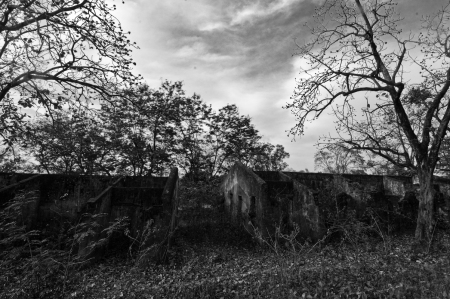
Abandoned government offices for the Mandal dam at Latehar district of Jharkhand.

Scene from outside the polling center at Daltonganj, Palamau, at the end of polling.

At the polling station at Dorami Panchayat at Latehar district on the 10th of April, 2014




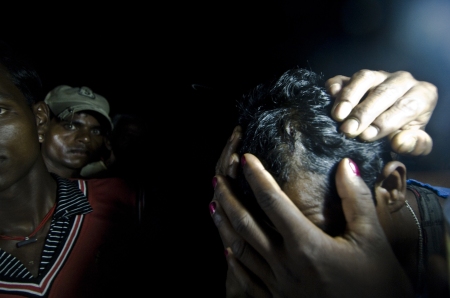
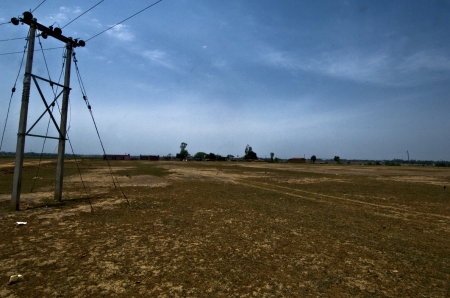

 The polling booth at Mayapur, Palamau District of Jharkhand on the 10th of April, 2014.
The polling booth at Mayapur, Palamau District of Jharkhand on the 10th of April, 2014.












 The Aftermath of a flood: The house of Sundar Lal Varma at Chikalda village. A fisherman by trade, his house was entirely submerged on the 24th of August, 2013. He has received no compensation or help from the state as of the 2nd of October, 2013.
The Aftermath of a flood: The house of Sundar Lal Varma at Chikalda village. A fisherman by trade, his house was entirely submerged on the 24th of August, 2013. He has received no compensation or help from the state as of the 2nd of October, 2013.
